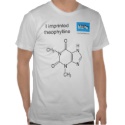|
|
Reference type: Journal
Authors: Javanbakht M, Fard SE, Mohammadi A, Abdouss M, Ganjali MR, Norouzi P, Safaraliee L
Article Title: Molecularly imprinted polymer based potentiometric sensor for the determination of hydroxyzine in tablets and biological fluids.
Publication date: 2008
Journal: Analytica Chimica Acta
Volume: 612
Issue: (1)
Page numbers: 65-74.
DOI: 10.1016/j.aca.2008.01.085
Alternative URL: http://www.sciencedirect.com/science/article/B6TF4-4RTW3VN-2/2/0534340799c9fcdcdd9221303237dd55
Abstract: Molecular imprinting is a useful technique for the preparation of functional materials with molecular recognition properties. In this work, a biomimetic potentiometric sensor, based on a non-covalent imprinted polymer, was fabricated for the recognition and determination of hydroxyzine in tablets and biological fluids. The molecularly imprinted polymer (MIP) was synthesized by precipitation polymerization, using hydroxyzine dihydrochloride as a template molecule, methacrylic acid (MAA) as a functional monomer and ethylene glycol dimethacrylat (EGDMA) as a cross-linking agent. The sensor showed a high selectivity and a sensitive response to the template in aqueous system. The MIP-modified electrode exhibited a Nernstian response (29.4 +/- 1.0 mV decade-1) in a wide concentration range of 1.0 x 10-6 to 1.0 x 10-1 M with a lower detection limit of 7.0 x 10-7 M. The electrode demonstrated a response time of ~15 s, a high performance and a satisfactory long-term stability (more than 5 months). The method has the requisite accuracy, sensitivity and precision to assay hydroxyzine in tablets and biological fluids
Author keywords: molecularly imprinted polymer, Potentiometric, carbon paste electrode, Hydroxyzine, biological fluids, tablets
|


 I imprinted theophylline T-shirt
I imprinted theophylline T-shirt







 magenta MIPs mug
magenta MIPs mug







 I love MIPs mug
I love MIPs mug






